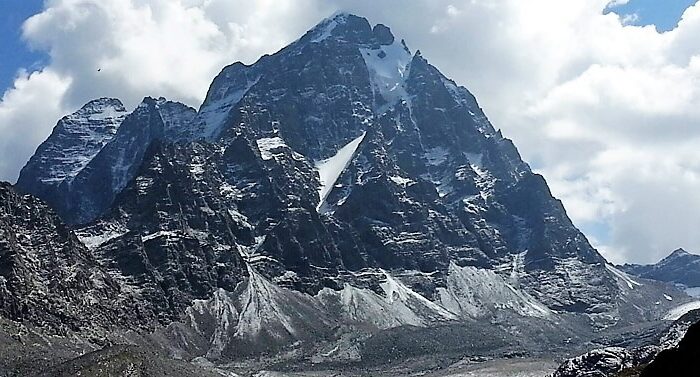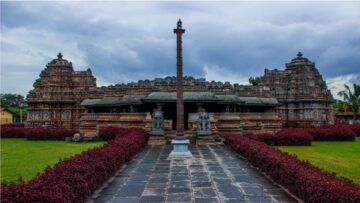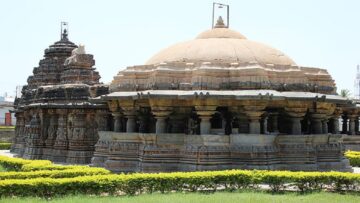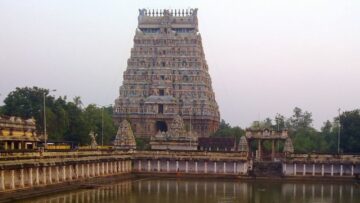For the Armenians, the greatest collective pain is to stand in their national capital Yerevan and look at their most sacred symbol, Mount Ararat. It is indeed sad because Armenia is a Christian country and Mount Ararat lies just across its national border in Turkey, a Muslim country which is guilty of committing a number of genocides of Armenians over the centuries. Mount Ararat, the sacred center – the very core of their religious, national and cultural consciousness is under the control of their enemy and there seems to be no respite.
Hindus are not exactly unaware of this pain. Their most sacred mountain, Mount Kailash, the abode of Lord Shiva, now lies in Tibet, occupied by China. Mount Kailash holds the most sacred of places in Hindu hearts. Along with being the abode of Shiva it is also the earthly representation of the mythical Mount Meru. It is from here that most sacred rivers of Bharat originate. And it lies across the border in China.
A Hindu is also sad that Kailash is not in Bharat and he too wants to get it back. But of note is the fact that unlike an Armenian, he is not without any respite. He has the recourse of recreating Mount Kailash within the boundaries of Bharat. He has the power of recreating sacred geography. And this feature is not something new since it has been interwoven into the very cultural fabric of Bharat.
The Monotheists destroy sacred centers of pagans wherever they go. All that the likes of Malik Kafur, Ibrahim Lodhi, Muhammad Tughlaq etc. left behind them, was a trail of death and destruction. On the other hand, the pagan polytheists create and recreate sacred geography wherever their cultural might extends. The Hindus were masters of this. That is why their sacred symbols were recreated not just in Bharat but wherever Hindu cultural influence extended.
This fact is not lost on any practicing Hindu but it becomes all too evident on a pilgrimage, a teertha yatra. It is the teerthas, the pilgrimages of Bharat, which have culturally bounded the entire nation in a shared cultural consciousness. The teerthas are the sacred centers of this land and the Yatras connecting these sacred kshetras are the spiritual and cultural highways, weaving the rainbow of dharma in Bharat. The teerthas are everywhere. No corner of the sacred land of Bharatvarsha exists without a sacred kshetra. They consecrate every corner of Bharatvarsha leaving no piece of land non-sacred. The sacredness, like the Brahma, is all pervasive.
Temples of Himachal
Himachal Pradesh has a special place in the sacred landscape of Bharat. Though it has all kinds of temples, it is primarily a land of Shiva and Shakti. While it sports various Shakti Peethas strewn all across its hilly terrain, the very mountains are the abodes of Lord Shiva. (Nagar 1) The mountains, icy cold and forever laden with snow are the favourite haunts of Shiva.
It was on a temple trail through the mountains of Himachal that I found myself striking up a conversation about Mount Kailash with my driver. We were going from Chamba to Bharmaur, the ancient capital of the Chamba region. The Ravi River valley around Chamba is one of the most exquisite valleys of the Himalayas – so near to the Ganga Jamuna Doab and yet so secluded. The Shivalik hills completely sequestered it from the mainland Punjab. One has to climb through the tough mountains to climb down into the Chamba valley which is surrounded by the Shivaliks in the West, the Dhauladhars in the South, the Mani Mahesh range in the East and more mountain ranges in the North.
Its seclusion certainly makes it hard to visit, but it has also saved it from various medieval and modern ills. Due to its inaccessibility it remained relatively safe from Islamic invasions, as compared to Kangra, its cousin to the south of it. Even in modern times, the pollution from the plains of Punjab can’t reach the Chamba valley so easily, making for the bluer skies and cleaner air.
The road to Bharmaur is tough. We were on it for more than a couple of hours and the ancient city, lost as if in the middle ages was nearing mile by mile. We were negotiating one hairpin bend after another, clearing one cliff after other. It is a gut wrenching ride and your heart literally stops at the many turns, but as soon as you make the turn and the vista of snow laden mountains opens in front of you, you forget everything else.
Before one such turn, my usually reticent driver suddenly brightened up and said that after this turn, we will have the first darshana of Mount Kailash. Kailash? Really? I was taken aback a little. I knew we were far away from civilization, deep into the mountains, alongside the Valley of Ravi River, but had we come so deep into the mountains that the Mount Kailash was visible here, all the way from Tibet? I knew the thought was ridiculous, but I still asked, was this the original Kailash?
My driver looked at me with great puzzlement at the utterance of the word ‘original’ and not without a ‘sigh’ which common Hindus generally give while conversing with a university de-educated person. What do you mean original? What other kind of Kailash is there? Kailash is Kailash and it was the one that we were going to have darshan of just moments later. And we did. It was the most ethereal of moments. A snow laden peak with its entire range emerged from the heavens just after we took the turn.
It was the Mani Mahesh Kailash. Though the greatest of all Kailash mountains lies now in China occupied Tibet, there are many Kailashas in Bharat, and at least four in the hill states of Himachal and Uttarakhand: Mani Mahesh Kailash in Chamba district, Shrikhand Kailash in Kullu district, Kinnaur Kailash in Kinnaur district of Himachal Pradesh and Adi Kailash in the Pithoragarh district of Uttarakhand.
For the locals none of these is a lesser Kailash. Every single one of them is the Kailash. For a devotee the sacredness does not decrease but increases with the replication of this sacred geography, with the repetition of the same sacred mountain at different places. And the legends weave them all together. All of them are the original Kailashas in some time and place and thus equal importance is imparted to each and every one of them.
All of them are special, for the legend dictates that Lord Shiva resides in all of them. Every local legend describes its own Kailash, its own teertha, being at the centre of a great myth. The Adi Kailash of Uttarakhand is considered the most ancient one. The Mani Mahesh Kailash is considered by the locals to be the actual abode of Lord Shiva while the villagers of Saho village, living around the Chandrashekhar temple believe that it is from here that Shiva embarked upon his journey and finally settled down in Mani Mahesh Kailash.
A Circular View of Time
While Mount Kailash is at the center of an international circuit of Hindus, the sacred circuit repeats itself many times at many smaller levels. The legends that are true at a bigger level mutate and reappear slightly differently but markedly similar in meaning and purpose at every level, like fractals. The same sacred web of meaning and myth is recreated at many levels.
The Hindu view of time is not just linear. In one lifetime and in daily chores, the linear time has relevance and the common man obviously knows the past from present and future. But his larger sense of time, encompassing long time spans and great civilizations, is circular.
Things, events and even individuals come back on each other in great loops of time, in ever repeating, ever different yet universal themes of myths and meaning. That a beginning can follow an end doesn’t bother a Hindu too much. He takes it in his stride. This view of time is woven in his rituals, his mythology and his scriptures. The Mahabharata starts in many ways at the end, or long after its end, and then the story loops back on itself many times.
A culture with this circular view of time has not much use of chronology. He is scarcely bothered with what came before and what came after. Meaning is far more important to him than chronology or provenance. And to such a devotee the concept of ‘original teertha’ and its copies doesn’t strike too much. For him, every teertha is original. Every kshetra is sacred.
No Concept of One True Kshetra
This does not mean that he sees all space and time in an undifferentiated sacredness. This would negate all concepts of sacred kshetras. But there is no concept of ‘One True Kshetra’, like there is no concept of One True God, One True Book or One True Belief. That sacred can attain many avataras, that time can repeat, and that kshetras and sacred centers can repeat and recreate themselves is a sense so central to the Hindu consciousness that no devotee is even conscious about it. For him the fact that divinity can repeat itself at various places and times is as natural as the belief in the universal presence of air and other elements.
For a devout Hindu to consider one Kailash to be original and other to be copies would necessitate a belief in only a linear view of time, because the concept of originality is wedded to the linear view of time. If time can repeat on itself in Yugas, the very words ‘original’ and ‘copies’ lose all meaning. For a devout Hindu like this, time becomes circular, space repeats itself in sacred circuits, and teerthas reappear like fractals at every receding circle of geography.
The Mani Mahesh Kailash fulfills all the requirements of a Kailash. It is perpetually laden with snow. It belongs to a range which is well nigh impassable. It has a sacred lake at its feet which is the center of a great pilgrimage circuit across the great Chamba region. People from all the state and the entire district gather here during the sacred month of Mani Mahesh Yatra.
Linear View of Time and Chronologies of Influence
The thoughts of ‘original’ and ‘copies’ are the result of a university education addled with a linear view of time and chronologies of influence. For a Hindu with a circular view of time, and with a different hermeneutics than history, the Kailash that is nearest to him, that is most closely wedded to the cultural setting of his birth, is the original Kailash. He believes in this with full knowledge that other Kailashas also exist. For him sacredness is not exclusive and it can repeat not just in different gods and divinities but also in the same name at different places and times.
Recreation of Sacred Kshetras
Kailash is not the only sacred teertha that is recreated. This is not the place to mention them all but a few names will illustrate the view point. For example, there are many Gangas. Godavari is Dakshin Ganga, but so is Kaveri. Even sacred ponds like the temple tank of the Brihadeeswar Temple, Gangaikondacholapuram is also considered Ganga. Across the seas, in the south-east Asia, the Mekong, the tenth largest river of the world (larger than Ganga), is literally Maa Ganga (Me + Kong).
Ayodhya is an eternal city. The capital city of Thailand until just a few centuries ago was Ayutthaya. Mathura is recreated in deep south, in Madurai. Kashi is recreated in Kanchipuram. Not only the teerthas or the sacred mountains and rivers are recreated, but also the entire circuits are recreated like the Char Dhams. There are the Char Dhams sanctified by Adi Shankara: Badrinath, Dwaraka, Rameshwaram and Puri. But Uttarakhand has its own Char Dhams: Gangotri, Yamunotri, Badrinath and Kedarnath. Kedarnath is not one. There are five Kedar temples in Uttarakhand itself called Panch Kedar.
The concept of Char Dhams is repeated on ever smaller scales in ever smaller circuits but with the same sacredness. Morena district in the northernmost parts of Madhya Pradesh has its own local Char Dhams: Bairare, Ishwara, Shyam Dev Baba and Dev Van. These four local teerthas are great centers for the people of Morena and the Chambal Valley. Great gatherings occur on many festivals at these temples various times across the year and for those who visit them for darshana, these Dhams are no less than the great Char Dhams.
In this spirit, a Hindu looks on across the border with wistfulness in the direction of the great Mount Kailash but not without absolute dismay. He, of course wants that Mount Kailash should also be included in Bharat’s national boundaries at some point of time in future, but in the meanwhile he has the recourse of the many Kailashas that are still a part of the sacred geography of Bharat, four of which lie in the state of Himachal Pradesh itself.
Explore Dharmic Circuits
Notes and References
Nagar, Shanti Lal. The Temples of Himachal Pradesh. Aditya Prakashan. 1990.
Image Credit: trekkinginindia
Disclaimer: The opinions expressed in this article belong to the author. Indic Today is neither responsible nor liable for the accuracy, completeness, suitability, or validity of any information in the article.











